#old monastery
Explore tagged Tumblr posts
Text

Bachkovo Мonastery // Plovdiv Area // Bulgaria
#Bachkovo Мonastery#old monastery#bulgaria#bg#balkan#trip#travel#plovdiv#plovdiv city#historic place#world history#black sea#history#bulgarian#memories#traditional#traditional art#traditional painting#arhitecture
2 notes
·
View notes
Text
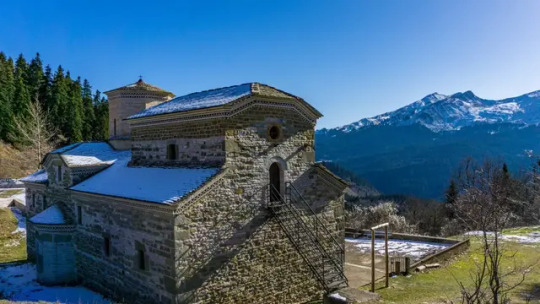
Η μονή της Αγίας Παρασκευής,κοντά στο Νεραϊδοχώρι,Τρικάλων
Το μοναστήρι της αγίας Παρασκευής κτίστηκε το 1792 απ' το Γιώργο ή Γούσιο Χατζηπέτρο δίπλα στο εκκλησάκι της Μεταμόρφωσης του Σωτήρα, που πιθανότατα ήταν κτισμένο πριν απ' το 1792. Είναι βασιλικού ρυθμού με τρούλο.
Το μοναστήρι είχε πρόβατα, γίδια, γελάδια και χωράφια. Τα χωράφια καλλιεργούσαν κοληγάδες (δηλ. άτομα που έπαιρναν το 1/2 ή το 1/3 της παραγωγής, μισακάρηδες ή τριτάρηδες). Την επίβλεψη έκαναν οι ηγούμενοι και οι καλόγηροι που έμεναν στα κελιά του μοναστηριού και ξεπερνούσαν τα 30 άτομα. Ώς ηγούμενοι αναφέρονται ο Δαμασκηνός, ο Ευλόγιος, Κήριλος και ο Χριστόφορος. Ώς καλόγηροι αναφέρονται ο Γεννάδιος και ο Νεόφυτος το 1911. Η διαμόρφωση του χώρου του μοναστηριού έγινε το 1977 με δωρεά του Κλέαρχου Δημητρίου και η πέτρινη βρύση κτίστηκε το 1980 με τη φροντίδα του παπα-Χρήστου.
#μοναστήρι#Αγία Παρασκευή#Νεραιδοχώρι#Τρίκαλα#ιστορία#ορεινό χωριό#Agia Paraskevi#Neraidohori#Trikala#Greece#mountain village#monastery#old monastery#1792#snow on the roof
3 notes
·
View notes
Text


[ID in alt]
Then & Now
HAPPY 14TH ANNIVERSARY NINJAGO HRHGHGHHHH
#zane n lloyd the fambly ever#i just drew them cuz i love them and also i didn't want to draw a bajillion ppl#anyway#14 YEARS#GOSH#and i've been here for TWO of these anniversaries now how crazy is that#fun facts about these drawings btw:#had to redo the first background bc i had it as the old monastery#and then i remembered AGAIN that the monastery was destroyed before lloyd joined#<- motherfucker who needs to re-watch the first several seasons#and on the second piece:#yes i put lloyd in a tanktop just bc i wanted to show off the dragoni features that i slapped on that man#anyway bye i made these in a haze of hyperfixation and now im going to hibernate for a few weeks#sunn art#dont repost#lego ninjago#dragons rising#lloyd garmadon#zane julien#fanart#artists on tumblr#ninjago 14th anniversary
745 notes
·
View notes
Text
I keep remembering various DW expanded universe material where time lords are compared to Christian priests in different ways and it’s like ????? That is Always on my mind. Always. Time Lordism as religion. As asceticism. As being pure and holier than thou and strict and adherent. As puritanism. As deprivation and isolation and devotion. I am Thinking about it!!!!!!
#they were designed in the 70s episodes to be like a cross between a Victorian gentleman’s club and the Vatican#the Vatican!!!!!!!#and in various things they have a lot of stuff structured like old university institutions#which in European tradition are based on medieval monasteries#Rassilon is not just framed as founding time lord society but as overthrowing old religions specifically#romana is a priest in the other universe in the blue angel supplemental material#recently listened to some fifth doctor stuff that compares him to a monk/priest???#there’s gallifreyan monks who can regenerate also????#and the gothic cathedral aesthetics brought in by the Gallifrey audios#lots of thoughts. about religion on Gallifrey and time lord society as religion#like literally are they the Catholic Church. are they the medieval Catholic Church#they’re. literally cloistered scholars. i think we should talk about this more#gallifrey audios#Gallifrey#dw lore#dw meta
62 notes
·
View notes
Text
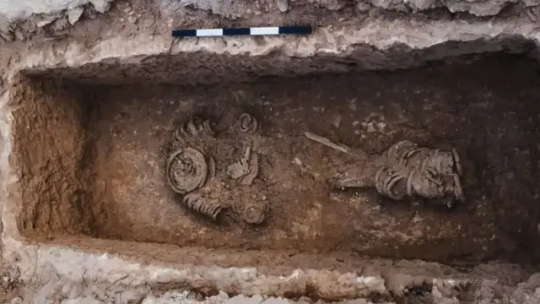
1,500-Year-Old Skeleton Found in Chains in Jerusalem was a Female 'Extreme Ascetic'
Not far from Jerusalem, archaeologists have discovered the fifth-century burial of a person wrapped in heavy metal chains. But the Byzantine-era grave held another surprise: The person who had practiced religious bodily punishment was female.
Excavations of a series of crypts at the Byzantine monastery at Khirbat el-Masani, about 1.9 miles (3 kilometers) northwest of the Old City of Jerusalem, revealed the skeletons of several men, women and children. One tomb contained the poorly preserved bones of an individual wrapped in chains. The corpse was not constrained for nefarious reasons, archaeologists suggested. Rather, the chains were used by the person during life to limit mobility as a part of a religious ascetic lifestyle. Initially, the Israel Antiquities Authority, which oversaw the dig, reported that this individual was male.
After Christianity became the main religion of the Roman Empire in A.D. 380, there was a surge of new monasteries and asceticism, in which monks abstained from worldly pleasures for spiritual purposes. A common practice of asceticism involved living at the top of a pillar while preaching and praying, often with heavy chains worn around the body.
In a study published in the April issue of the Journal of Archaeological Science: Reports, researchers studied the bones in the chain-filled burial with the goal of confirming the person was male. But they got a big surprise: the person was probably female.
"The use of chains by male ascetics is widely documented," study co-author Elisabetta Boaretto, an archaeologist at the Weizmann Institute of Science in Israel, told Live Science in an email, but "it's much rarer to find accounts of women using chains in the same way."
The person appeared to be between 30 and 60 years old at the time of death, but the bones were poorly preserved. So the researchers analyzed peptides — short chains of amino acids — in the person's tooth enamel to figure out their sex.


They found the presence of AMELX, an X-chromosome gene involved in enamel development, but no evidence of AMELY, the Y-chromosome gene that codes for the same thing. This meant the person very likely had two X chromosomes and was female.
"It is important to note that our results only show biological sex identification and not gender preference," the researchers wrote in the study.
Female ascetics are known from historical records, the study authors said, particularly among nobility starting in the fourth century. However, women in ascetic communities tended to pursue their spiritual paths in different ways that were generally less extreme than those practiced by men, Boaretto said. Prayer, fasting and meditation were more likely to be integral to women's spiritual journeys.
As physical restraints, chains were a more extreme way to practice asceticism, Boaretto said, as they were meant to keep the body in check and the spirit focused. "By restricting their physical movements, they created space for their minds and hearts to turn solely to God," she said.
Although other chained burials of ascetics have been discovered in the past, the identification of a woman buried in this way is highly unusual.
"The chains were likely viewed as integral to her identity as an ascetic," Boaretto said, and her burial "may have served to honor her ascetic life and ensure that her spiritual commitment continued to be recognized even after death."
By Kristina Killgrove.

#1500-Year-Old Skeleton Found in Chains in Jerusalem was a Female 'Extreme Ascetic'#Byzantine monastery at Khirbat el-Masani#ancient grave#ancient tomb#grave goods#ancient artifacts#archeology#history#history news#ancient history#ancient culture#ancient civilizations#byzantine-era#ancient israel
39 notes
·
View notes
Note
I find little Machete being happy over bread baking to be so endearing, especially because I can imagine a world in which helping with baking was one of the few childhood joys he had (due to the lack of art of him happy as a pup), and then remembering the art you did months back of modern Machete making a souffle, I can see reincarnated Machete being drawn towards baking in his free time due to those residual feelings from his past life.
.
#aww dang#it's funny you remembered the souffle and made that connection#I didn't even think of that but it's very fitting#to be fair the part of his childhood he spent as an oblate in the monastery was relatively worry-free and uneventful#small children are good at making their own fun it often doesn't take much to make them happy#Machete was nervous and sensitive as a kid that's just part of his innate personality but that doesn't mean he was miserable all the time#things started to get difficult when he was old enough to start his apprenticeship#and his master was way harsher than he was prepared to handle#answered#lunalemures#his life would've been less turbulent if he had chosen to stay in the monastery and become a monk instead of pursuing a clerical career#baking bread or tending the library#with bland regular meals twice a day and bedtime at 6 pm#but he would've never met Vasco of course
239 notes
·
View notes
Text

Mężczyzna nad rzeką Osławą w pobliżu ruin klasztoru Karmelitów bosych w Zagórzu (1936).
16 notes
·
View notes
Text


The Transfiguration Basilica of the Sinai Monastery with the Burning Bush
15 notes
·
View notes
Text
📍Old Kardamyli Peloponnese Greece 🇬🇷
“Am I dreaming? No. I’m living in my dream”.
Wandering through Old Kardamyli feels like stepping into a timeless reverie, where ancient stone towers whisper tales of bygone eras and Byzantine churches stand as guardians of history.
Did you know?
Kardamyli’s roots trace back to Homer’s ‘Iliad.’
Here, every corner is a blend of myth and reality, a dance of shadows and light.
Come, lose yourself in its enchanting embrace.
@newsfromthevillage
Καλημέρα Ελλάδα!!
#oldkardamyli #timelessbeauty #travel #travelingare #peloponnese #greece #kalimera #ellada
#lifestyle#myuploads#aesthetic#travel#travelingare#photography#architecture#drone photography#kalimera ellada#greece#old kardamyli#peloponnese#monastery
26 notes
·
View notes
Text
I think we, as a fandom, should run with the joke and pretend that we spent an entire season with the random characters
#dimension 20#fantasy high#junior year spoilers#like do you remember when squeem tried to ride on the hangman and crashed it into an old elven monastery#classic squeem!
129 notes
·
View notes
Text
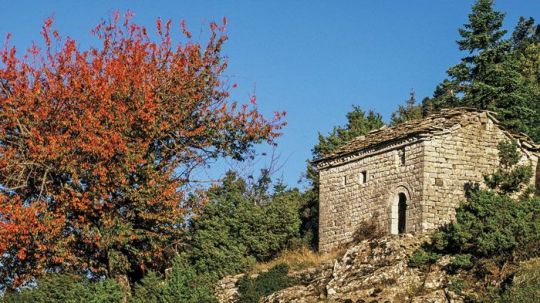
Ι. Μ. Αγίου Δημητρίου Κρυονερίων
Το μοναστήρι του Αγίου Δημητρίου βρίσκεται στην τοποθεσία «Σέλπερη» νοτίως των Κρυονερίων Ορεινής Ναυπακτίας, είναι στην μέση περίπου της πλαγιάς Αετοράχης σε μέρος ομαλό και με μικρή κλίση προς τα ανατολικά.
Κτίστηκε το 1805 όταν ο τριανταπεντάχρονος τότε τσοπάνης Δημήτρης Τσουνόπουλοςή Τσώνης, από τα Κουτλίστια (σημερινά Κρυονέρια) ονειρεύτηκε ότι υπάρχει μία ιερή εικόνα στο πατρικό του χωράφι κοντά στο χωριό του και είδε επίσης τον Άγιο Δημήτριο να τον υποχρεώνει να κτίσει εκεί μια εκκλησία και να αφιερωθεί τόσο αυτός όσο και η οικογένειά του.
Ξύπνησε, πήγε στο χωράφι του, έσκαψε και βρήκε την εικόνα. Προσπάθησε να πείσει τους συγχωριανούς του αλλά δυστυχώς για αυτόν, δεν βρήκε την ανταπόκριση που ήθελε.
Τότε απευθύνθηκε στον Αλί Πασά και ζήτησε οικονομική ενίσχυση και την άδεια να κάνει εράνους στην περιοχή για να αναγείρει την εκκλησία.
Πηγή και περισσότερα στο:https://www.agriniopress.gr/dimitrioy-kryonerion/
#Άγιος Δημήτριος#μοναστήρι#Σέλπερη#Κρυονέρια#Ορεινή Ναυπακτία#Πελοπόννησος#19ος αιώνας#1805#ιστορική μονή#ιστορία#Ελλάδα#φθινόπωρο#ορθοδοξία#Saint Demetrios#monastery#Peloponnese#Greece#old monastery#orthodoxy
1 note
·
View note
Text
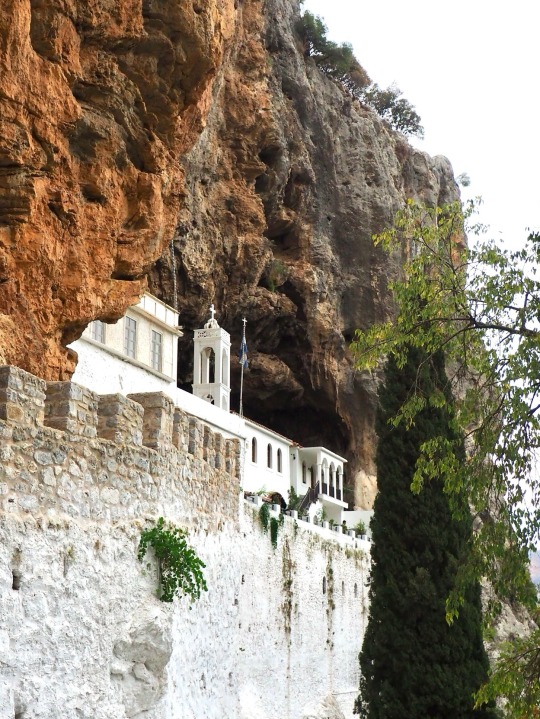

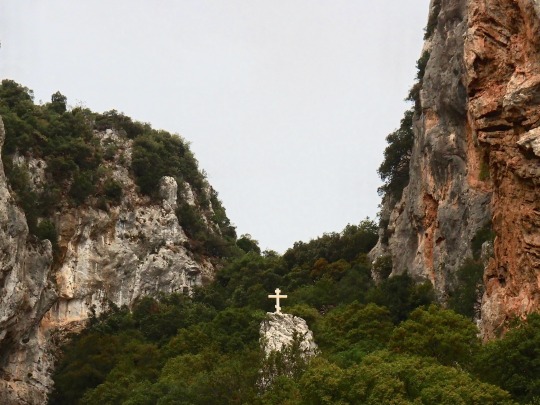
Monastery of Saint Nicholas of Sintza, Leonidio, Greece
#the spark in the eyes of the old nun who lives alone there is forever engraved in my memory#so glad#greece#mine#st nicholas#St Nicholas of Sintza#peloponnese#orthodox monastery#Orthodoxy
29 notes
·
View notes
Text


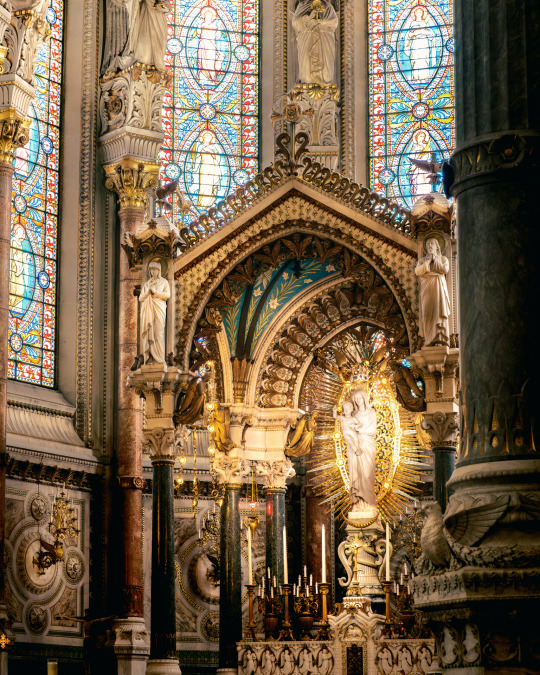
Cathedral Notre Dame of Lyon, France
#photography#fujifilm#x-h2#fujifilm x h2#architecture photography#architecture#cathedral#church#churches#monastery#old building#france#lyon
18 notes
·
View notes
Text

Minecraft Dark Old Mythical Town
#minecraft#minecraft project#minecraft build#minecraft art#minecraft builder#art#minecraft screenshots#project#minecraft house#minecraft house idea#goth#gothic#cathedral#churches#old building#architecture#monastery#church#old town#dark aesthetic#soul#dark souls#mythical art#mystery
67 notes
·
View notes
Text
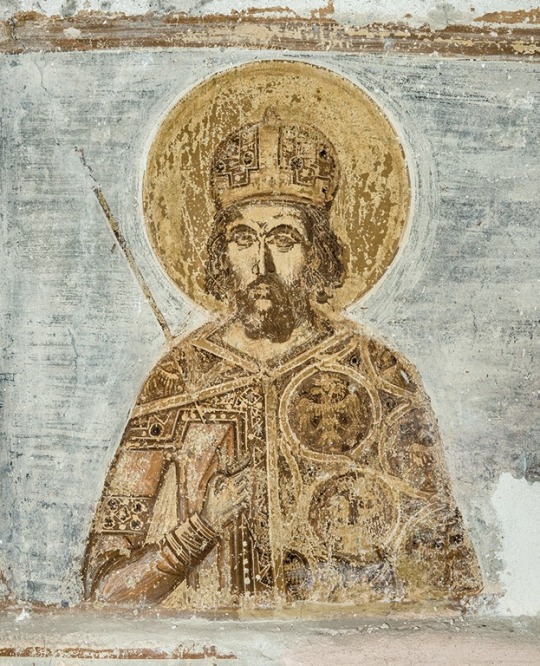
Rare Portrait of the Last Byzantine Emperor Discovered in Greece
The image of Constantine XI Palaiologos was probably painted from life.
A portrait of the final Byzantine emperor, Constantine XI Palailogos, has been discovered by archaeologists in Greece. The portrait was found on a mid-15th century fresco uncovered at a monastery in Aigialeia in the Achaea region of Western Greece.
Constantine XI Palaiologos ruled the Byzantine Empire for a short period between January 6, 1449 and May 29, 1453, dying in battle during the fall of Constantinople, when the capital was captured by the Ottomans. The Byzantine Empire had been steadily losing land since the 7th century and vanished entirely after the battle in 1453. The painting is the last known portrait of any Byzantine emperor created during their reign.
In the portrait, the emperor appears wearing regalia adorned with crowned double-headed eagles. These were symbols of the Palaiologos dynasty, which was the longest-ruling of the Byzantine Empire. It produced emperors and leaders for just shy of 200 years, between the 13th and 15th centuries.
He is also wearing a bejeweled crown and holding a cruciform scepter. His purple cloak would have been dyed from the liquid produced from the glands of the Bolinus brandaris sea snail, which was incredibly expensive and so was reserved for use only by royalty (said to be “born in purple”) during the Byzantine Empire. Following the fall of Constantinople, the harvesting farms of the snails were destroyed by the Ottoman Turks, but the association of purple with royalty lives on.

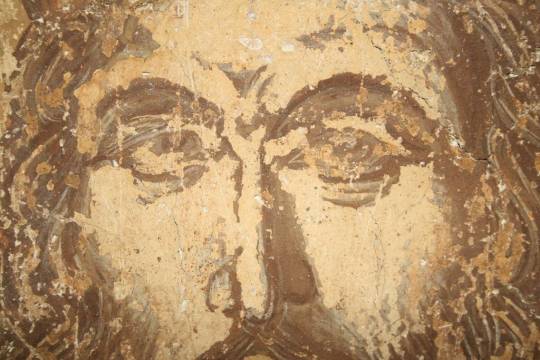
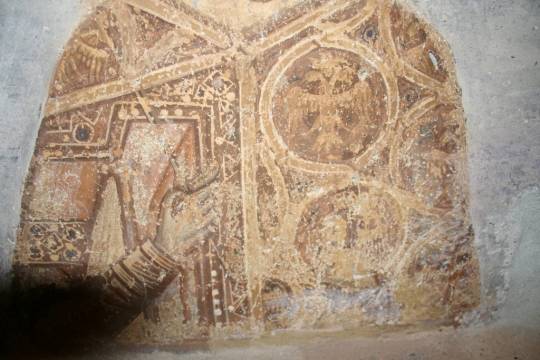

The fresco is believed to be the work of an artist from Mystras, a town south of the Aigialeian monastery, where a young Constantine lived and ruled for five years before his ascension to emperor. The Holy Monastery of Pammegiston Taxiarchon had once been the recipient of significant financial donations from Constantine’s brothers. It was during recent restoration of the monastery that the fresco containing the portrait of the Byzantine emperor was discovered.
The Greek Minister for Culture, Lina Mendoni, called the portrait “the only known depiction” of Constantine XI Palaiologos “created during his lifetime.” His short rule meant that few portraits of him have been discovered. Mendoni added that “the artist likely painted the emperor’s features from direct observation, rather than relying on an official imperial portrait, as was customary.”
In a statement, the Greek Ministry of Culture referenced the “authenticity” of the portrait, which “accurately renders the physiognomic features of the last Byzantine emperor.” It describes the likeness, calling the portrait a depiction of “an earthly figure, a mature man, with a delicate face and individualized features, who exudes calm and nobility.”
By Verity Babbs.

#Rare Portrait of the Last Byzantine Emperor Discovered in Greece#Constantine XI Palaiologos#painting#fresco#the Old Monastery of the Archangels#art#artist#art work#art world#art news#ancient artifacts#archeology#archeolgst#history#history news#ancient history#ancient culture#ancient civilizations#byzantine empire#byzantine art#ancient art
51 notes
·
View notes
